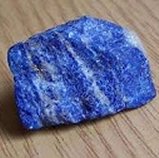| Chemical Composition: |
Complex Mineral Group
(Na,Ca)8(Al,Si)12O24(S,SO)4 |
| Color: |
Bright Blue, Violet Blue and Azure Blue - Greenish Blue |
| Hardness: |
5 - 5.5 |
| Specific Gravity: |
2.3 - 2.4 |
| Cleavage: |
Poor |
| Fracture: |
Uneven |
| Crystal Structure: |
Transparent to opaque; isometric |
| Environment: |
Crystals are rare. It is usually granular, compact, massive. It forms in association with pyrite, calcite, and diopside in hornfels of contact metamorphic rocks. The opaque, vivid blue, light blue, greenish-blue, or violet-blue stone, consisting largely of lazurite but with appreciable amounts of calcite, diopside, and pyrite, is a rock called [lapis lazuli.] The stone is usually veined or spotted. Its value depends largely upon excellence and uniformity of color and absence of pyrite, although some purchasers prefer lapis with pyrite. |
| Luster: |
Dull to greasy |
| Streak: |
Bright Blue |
| Occurence: |
Lazurite is a rare mineral in North America, but it does occur on Italian Mt. in the Sawatch Mts. of Colorado; on Ontario Peak in the San Gabriel Mts., Los Angeles Co., and in Cascade Canyon in the San Bernardino Mts., San Bernardino Co., California. The finest lapis lazuli has come from Badakshan in Afghanistan, and less valuable material has come from Russia and Chile.
Afghanistan, Chile, Russia, Italy, and USA |
| Name: |
The name is from the Arabic [lazaward], "heaven," which was also applied to sky-blue lapis lazuli. |
| Healing: |
This stone is used at the Ajina, the Brow Chakra. It's related gland is the pituitary. The pituitary gland is also referred to as the "master gland" because it regulates all of the others. This location is also the center for the eyes, ears, nose and brain. |
| Energy: |
Receptive |
| Planet/Sign: |
Venus; Moon/Cancer; Mercury/Gemini; Saturn-Uranus/Aquarius |
| Element: |
Water |
| Deities: |
Isis, Venus, Nuit |
| Associated Metal: |
Gold |
| Powers: |
Healing, love, joy, protection, fidelity, psychism, courage |
| Magical Uses: |
"This stone is used in rituals designed to attract spiritual love. Take an untumbled piece of lapis with a sharp edge. Empower the stone and a pink candle with your need for love. Then, using the lazurite, carve a heart onto the candle. Place the stone near the candleholder and burn the candle while visualizing a love coming into your life." Actually, the most important magical aspect of lapis is it's ability to strengthen psychic awareness.
- Touching the body with this stone improves, mental, psychical, spiritual, physical, and emotional conditions.
- Use to alleviate fevers and diseases of the blood.
- Strengthens eyesight.
- Use in healing magick and rituals.
- Useful for relieving depression and promoting spirituality.
- Great for meditation.
- Use in rituals to attract spiritual love.
- Use as a talisman to enhance fidelity.
- Strengthens psychic awareness and use for divination.
- A good protection stone for children.
- Induces courage and removes nervousness, phobias and anxiety.
|
| Stone Lore: |
Most of the world's lapis is currently found in Central Asia or Afghanistan.
Lapiz Lazuli was widely used as an ornamental stone in Greece and Rome, and was an important magickal stone in ancient Babylonia, Assyria, and Egypt. Carved into bird and animal forms and made into jewelry, lapis was intended to protect the wearer from harm. Lapis was also fashioned into the shape of a heart, the Egyptian symbol for the "seat of life", as they beleived that the stone could bring about resurrection following death. The Egyptian Book of the Dead shows a powerful lapis amulet in the form of an eye, most likely to ward against evil.
Lazurite was a favorite stone of the ancient Egyptians. In the past Lazurite has been burned and ground to form the pigment "ultramarine." It was consider an aid to childbirth, and has long been associated with altered states of consciousness and trance work. Lapis is sometimes designated as a birthstone for December, although turquoise is most common. |
| Medicine Uses: |
Lapis may be used to cure depression, sadness, mourning, and grief, as this stone exerts a strong influence in matters of the heart, including faithfulness and love. It can be used to treat physical heart conditions as well.
Lapis can keep the eyes healthy and the vision clear. Prepare an eyewash by placing lapis in a bowl of purified water overnight along with several drops of the herb eyebright. In the morning, splash the treated water into your eyes.
Lapis increases the psychic senses, as it works to fine tune the feelings and instincts. Deep azure blue, pyrite streaked stones are potent healing medicine when worn with purposeful intent, and may help the wearer to develop clairsentient and telepathic powers.
Vedic healers suggest that lapis be set into a gold necklace for optimum benefits. |
